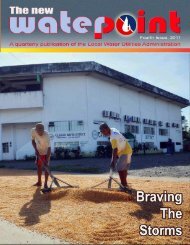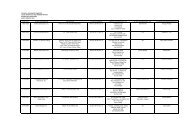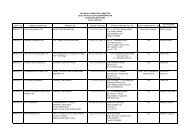Philippine National Standards for Drinking Water - LWUA
Philippine National Standards for Drinking Water - LWUA
Philippine National Standards for Drinking Water - LWUA
You also want an ePaper? Increase the reach of your titles
YUMPU automatically turns print PDFs into web optimized ePapers that Google loves.
2.9 Standard Values <strong>for</strong> Inorganic Chemical Constituents with Health<br />
Significance<br />
Constituent<br />
Maximum<br />
Level (mg/L)<br />
Remarks (Sources/Occurrence)<br />
Antimony 0.02 Antimony is a contaminant from pipe and<br />
fitting materials. It is not a raw water<br />
contaminant.<br />
Arsenic 0.05 For existing water supply systems.<br />
Arsenic may be naturally occurring in water<br />
sources. Where maximum level of arsenic<br />
is unachievable, concentration in water<br />
supply must be kept as low as possible. By<br />
2010, the maximum level shall be 0.01<br />
mg/L<br />
Barium 0.7 Barium occurs naturally as trace elements<br />
in both igneous and sedimentary rocks.<br />
Boron 0.5 Present in surface water due to discharge<br />
of treated sewage effluent, which still<br />
contains detergents; could be naturally<br />
occurring in certain areas. Maximum level<br />
has been elevated from 0.3 mg/L (PNSDW<br />
1993) to 0.5 mg/L (PNSDW 2007) because<br />
it is difficult to achieve in areas with high<br />
natural levels and limited access to<br />
treatment technology.<br />
Cadmium 0.003 Cadmium is used in manufacture of steel,<br />
plastics and battery and released to the<br />
environment through wastewater or fumes.<br />
Cadmium is released in water supply as<br />
impurity of the zinc coating of galvanized<br />
pipes and solders and metal fittings.<br />
Chromium (Total) 0.05 Chromium is widely distributed in the<br />
Earth’s crust. Occurs in wastewater in<br />
certain industries such as chromium plating<br />
of bumpers, grills and ornaments.<br />
Cyanide (Total) 0.07 Cyanides are occasionally found in drinking<br />
water primarily as a consequence of<br />
industrial contamination.<br />
Fluoride 1.0 In areas where high natural fluoride levels<br />
occur, the maximum level may be difficult to<br />
achieve due to limited access to treatment<br />
technology.<br />
Lead 0.01 Lead may be present in water primarily<br />
from plumbing systems containing lead<br />
pipes, solder, fittings or the service<br />
connections to the homes. Although it may<br />
be found naturally occurring in certain<br />
areas, rarely is it present in water supply as<br />
a result of its dissolution from natural<br />
sources.<br />
Method of Analysis<br />
FAAS. EAAS;<br />
ICP/MS;<br />
ICP/MS; hydride<br />
generation AAS; Silver<br />
Diethyldithiocarbamate<br />
Method, EAAS<br />
(Graphite furnace<br />
AAS)<br />
ICP/MS; FAAS; EAAS,<br />
ICP<br />
ICP/MS; ICP/AES<br />
ICP/MS; FAAS<br />
FAAS; EAAS, ICP,<br />
ICP/MS<br />
Titrimetric;<br />
Colorimetric; CN<br />
Selective Electrode<br />
Ion chromatography,<br />
Ion-selective<br />
electrodes; SPADNS<br />
colorimetric;<br />
Complexone Method<br />
FAAS; EAAS;<br />
ICP/MS; Anodic<br />
Stripping Voltammetry;<br />
Dithizone<br />
19







